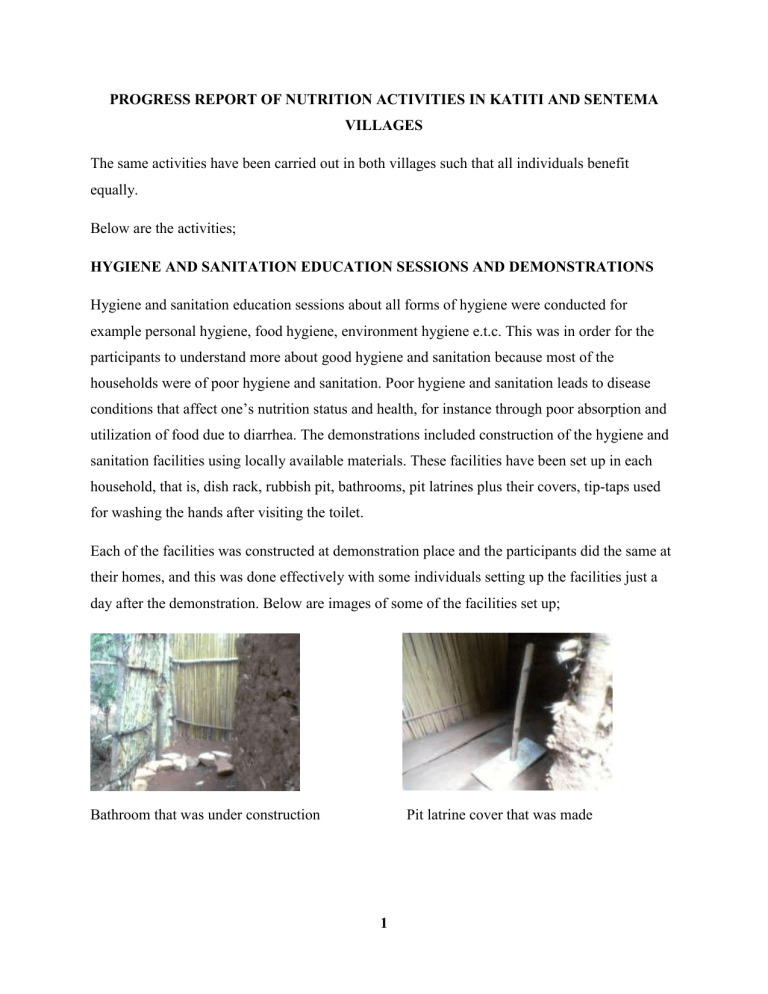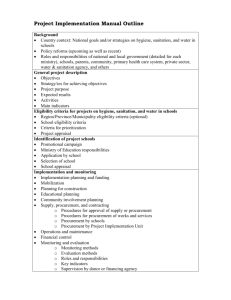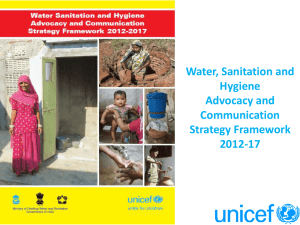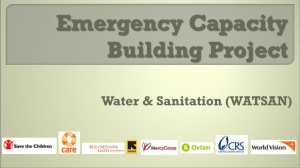Nutritionist_Report_Oct-2014

PROGRESS REPORT OF NUTRITION ACTIVITIES IN KATITI AND SENTEMA
VILLAGES
The same activities have been carried out in both villages such that all individuals benefit equally.
Below are the activities;
HYGIENE AND SANITATION EDUCATION SESSIONS AND DEMONSTRATIONS
Hygiene and sanitation education sessions about all forms of hygiene were conducted for example personal hygiene, food hygiene, environment hygiene e.t.c. This was in order for the participants to understand more about good hygiene and sanitation because most of the households were of poor hygiene and sanitation. Poor hygiene and sanitation leads to disease conditions that affect one’s nutrition status and health, for instance through poor absorption and utilization of food due to diarrhea. The demonstrations included construction of the hygiene and sanitation facilities using locally available materials. These facilities have been set up in each household, that is, dish rack, rubbish pit, bathrooms, pit latrines plus their covers, tip-taps used for washing the hands after visiting the toilet.
Each of the facilities was constructed at demonstration place and the participants did the same at their homes, and this was done effectively with some individuals setting up the facilities just a day after the demonstration. Below are images of some of the facilities set up;
Bathroom that was under construction Pit latrine cover that was made
1
The figures above show participant cutting the poles for making the tip-tap, participant making the poles firm, participant digging the hole respectively (the hole was after filled with stones and it is where water pours during the washing of the hands).
Participant making the tap participant using the tip-tap
Dish rack after construction
NUTRITION EDUCATION SESSIONS AND DEMONSTRATIONS
Nutrition education sessions and food demonstrations have been conducted, for instance about infant and young child feeding putting emphasis on exclusive breastfeeding and proper complementary feeding, conservation of food nutrients, balanced diet putting emphasis on the various food groups, use of good nutrition to improve the quality of life e.t.c .Food demonstrations about both nutritiuos foods for home consumption and nutritious foods for both home consumption and selling in order to generate income to provides needs of the family were
2
conducted. Here locally available foods were used. Some of the demonstrations were about pumpkin and onion soup, kitoobero, maize cake, cassava biscuits,soya doughnuts,nutrient dense porridge, the details are below;
CASSAVA BISCUITS
These were made from mainly cassava flour plus a few other ingredients and baked using sand.
They are rich in energy and also contain proteins from the eggs and milk. They can be used both for home consumption and for sale. The baking is done using sand.
The participants were very grateful because they only knew that cassava flour can only be used as food and for making the locally known pancakes but they never knew that they could make cassava biscuits out of cassava flour.
Participant measuring the participants using the rubbing in participant rolling out the
Margarine method pastry
Participant cutting out the biscuits baked biscuits (these were not glazed)
MAIZE CAKE
This is mainly comprised of maize flour and can be afforded by everyone. The maize cake not only satisfies hunger but also provides various nutrients which are useful to the body, for instance, energy from the maize flour, proteins from the eggs, fat and energy from the margarine e.t.c. It is a delicious cake. Below are some of the images about the cake making.
3
Participants measuring the Participant creaming the fat and cake after baking
Ingredients sugar
SOYA DOUGHNUTS
These are mainly comprised of soyaflour, an important source of protein thereby contributing to the nutrient needs rather than merely satisfying hunger and the desire to eat. These can be used for home consumption and for sale to earn some income.
Participant making the hole in the doughnut.
PUMPKIN AND ONION SOUP
The soup is rich in protein and vitamin A, it is suitable for the management of nausea, lack of appetite, constipation, mouth sores, diarrhea, cough and fever.
The pumpkin seeds were roasted and consumed immediately.
Preparation of the soup
4
SESSION ABOUT MAINTAINING GOOD NUTRITION THROUGH APPOPRIATE
FEEDING PRACTICES for example through having a balanced diet
Here an education session and demonstration were conducted. At the end of the session ,avariety of foods were brought, mixed up and the participants were given the task of separating the foods according to the different food groups and this was done without looking at the notes they had made.
guavasg
The figures above show the participant separating the foods, these included; cassava, sweetpotatoes, maize, maize flour, timpa(yam leaves), sunsa (pumpkin leaves), dodo
(amaranthus), nakati, egg plants, onions, eggs, silver fish, milk in the 2l jerrycan, guavas, pawpaw, oranges, tangerines, passion fruits, cassava leaves e.t.c
Participant in the final stage foods after being separated into the different food groups
5
KITOOBERO
This is a multiple food mixture normally comprised of foods providing all nutrients, for instance, energy from the maize flour, minerals such as calcium from the silver fish, proteins from the dry beans, water and iodine from the iodized salt.
This is suitable for weight gain, loss of appetite. It is rich in energy, protein, calcium e.t.c
Kitoobero is suitable in the nutritional management of undernourished children and can also be used as a complementary feed.
The participants liked the kitoobero so much in that even those who missed the learning wanted to learn it in (both villages) through a second demonstration, therefore, this was done two times in both villages.
APPROPRIATE FOOD HANDLING PRACTICES EDUCATION SESSION
This included more about personal hygiene, food and water handling plus waste disposal.
CONSERVATION OF NUTRIENTS EDUCATION SESSION
This involved how the nutritional value of different foods is affected, practices that lead to loss of nutrients, practices that conserve nutrients, practices that enhance nutritional value, preparation and choice of vegetables.
DEMONSTRATION: This was about preparation, cooking and serving of food. The emphasis was put on vegetables since they are the ones that most people wrongly prepare, cook and serve hence losing the nutrients.
PROGRESS OF ONE OF THE CASE STUDY
6
The child is gradually improving, weight had increased from 5kg to 6kg but she got sick and she lost some of the weight. But with the amaranth porridge that she is to start feeding on, she will improve greatly.
She can now walk. The ways of feeding and hygiene and sanitation at home have improved. The mother ensures a balanced diet is consumed at least everyday.
OTHER ACTIVITIES DONE
Taking the anthropometric measurements of the children and the reproductive age participants, expectant mothers in order to monitor their nutritional status but the details of these will be delivered in the next report.
Nutrition counseling is also done especially to the underweight individuals and mothers/caretakers of undernourished children.
WAY FORWARD
In addition to what is being done, the identified children are to start the feeding program. The necessities have been received and the feeding program will start next week.
More households (for each participant) are to be visited for efficient monitoring.
CHALLENGES
The changing weather especially the heavy rains which affects the travelling in the field and the studying due to lack of shelter.
Use of the phone camera which doesn’t give good images and sometimes completely fails to take the photos.
ACHIEVEMENT(S)
7
Hygiene and sanitation has improved.
Feeding practices have improved, for instance most of the participants ensure that they have balanced diet each day.
The communities have been involved in identifying their nutrition problems and implement appropriate interventions to address the problem.
The ways of food preparation and consumption have been improved.
The participants learnt how to bake using sand which they never knew.
Creation of income-generating activities for women such as baked products for sale as mentioned above.
Over thirty participants attend the lessons, if less, they are between twenty and thirty.
CONCLUSION
Most of the objectives according to the plan for the nutrition services have been achieved, among these are the achievements above.
The participants are very grateful for the work done and most importantly they do put to practice what they learn and this shows that they enjoy what they are doing thereby improving quality of their life through nutrition.
8









